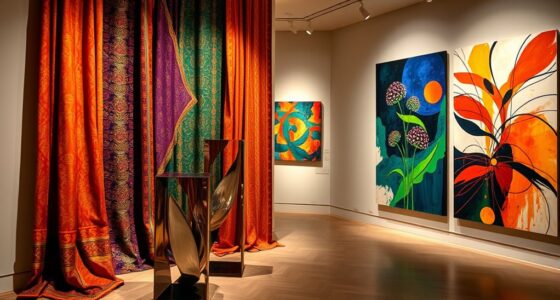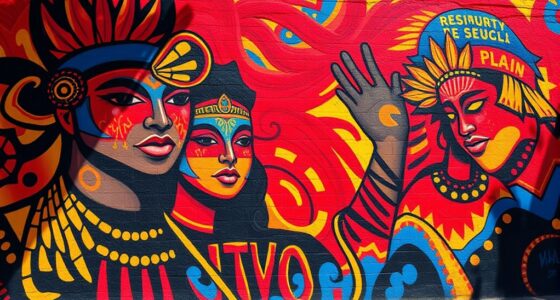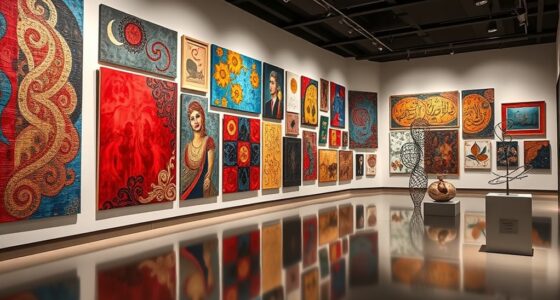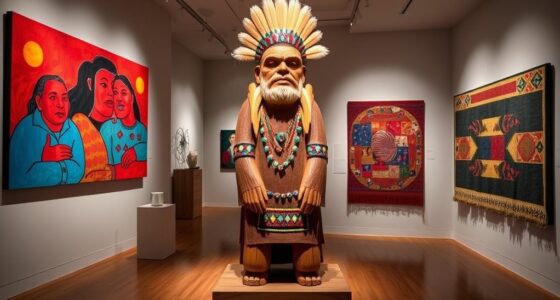The Scandinavian art scene blends its rich history, from Viking craftsmanship and folk traditions to modern minimalism inspired by functionalism and innovative design. You’ll see how pioneers like Aalto and Jacobsen shaped contemporary aesthetics, emphasizing simplicity, sustainability, and social consciousness. Urban art, new media, and digital collaborations push boundaries further, making Scandinavian art both globally influential and deeply rooted in cultural identity. If you explore on, you’ll discover how these elements continue evolving into future creative directions.
Key Takeaways
- Scandinavian art emphasizes simplicity, functionality, and clean aesthetics rooted in Nordic design principles and minimalism.
- Modern Nordic artists integrate international styles like Cubism and Expressionism, blending tradition with avant-garde experimentation.
- Contemporary art incorporates digital media, eco-friendly materials, and immersive techniques to address environmental and social themes.
- Nordic design continues to prioritize sustainability, resourcefulness, and natural materials, shaping global trends in minimalism.
- Cross-border collaborations and digital platforms expand the reach of Nordic art, fostering innovation and cultural exchange beyond traditional boundaries.
Roots of Scandinavian Artistic Heritage

The roots of Scandinavian artistic heritage trace back to the Viking Age, roughly between 800 and 1100 CE, when craftsmanship played an essential role in daily life and spiritual expression. Viking art features intricate wood carvings, metalwork, and ship decorations with intertwined animal motifs and mythical beasts, seen in the popular Oseberg style. Vikings blended functional and decorative elements, with longships showcasing their craftsmanship and status. Norse mythology heavily influenced their art, embedding mythological themes that persisted in folk traditions. Excavations reveal highly skilled artisanship and symbolism used to communicate social and spiritual meanings. These early artworks laid the foundation for regional styles, connecting craftsmanship, mythology, and cultural identity that continue to influence Scandinavian art today. Additionally, the emphasis on design simplicity and harmony in their creations exemplifies the enduring Nordic minimalist aesthetic. The appreciation for minimalist design has persisted through centuries, shaping contemporary Scandinavian art and design philosophies.
From Folk Traditions to Modern Aesthetics
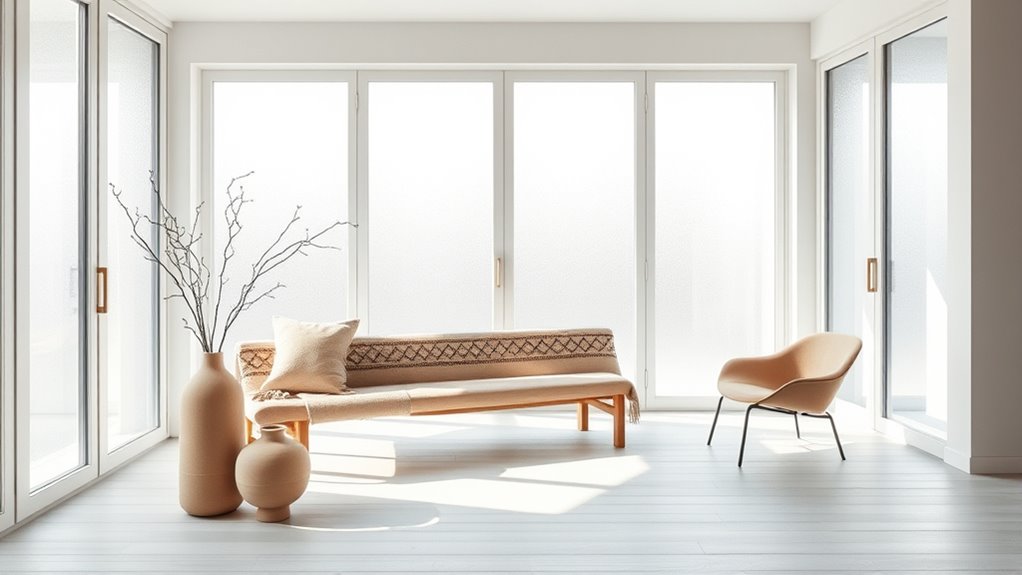
Folk traditions serve as a vital bridge between Scandinavia’s historical craftsmanship and its modern aesthetic expressions. You see, these roots trace back to Viking Age decorative practices, evolving through rural communities from the 17th to 19th centuries. They crafted woodcarvings, embroidery, textiles, and paintings, often inspired by nature—flowers, animals, landscapes—using colors that mirror local flora and fauna. These motifs emphasize symmetry and geometric patterns, reflecting natural order. Objects served both functional and decorative purposes, blending utility with artistry. Today, modern design borrows from these traditions—minimalist, geometric, vibrant—while contemporary artists reinterpret folk motifs across media. Regional variations in motifs and techniques continue to influence Scandinavian design, maintaining a connection to local identities. Folk art remains alive in festivals, galleries, and education, influencing fashion, interiors, and global trends, sustaining Scandinavia’s rich cultural legacy. Additionally, traditional techniques are often incorporated into contemporary craftsmanship, ensuring their preservation and continued relevance. Furthermore, craftsmanship fosters community identity and pride, reinforcing cultural continuity. Moreover, financial management can help artisans and designers sustain their craft in a competitive market. Recognizing the importance of material sustainability also supports the long-term viability of folk-inspired art practices. In recent years, the integration of Cultural Intelligence into design education has enhanced artists’ ability to adapt traditional motifs to diverse global audiences, expanding their reach and relevance.
Pioneers of Nordic Art Movements
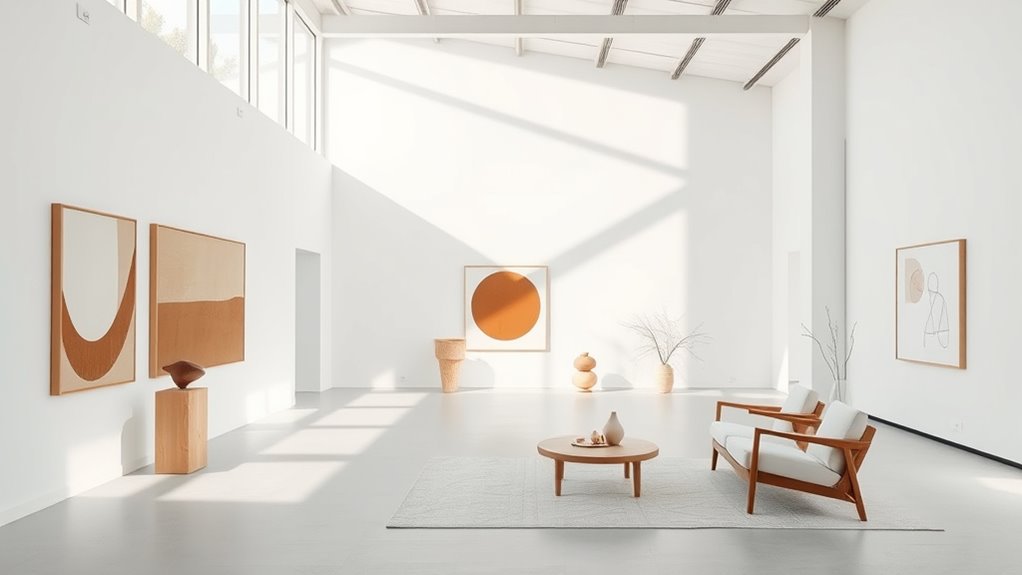
Nordic art movements gained momentum through pioneering artists who embraced international styles and pushed creative boundaries. These trailblazers integrated European influences like Cubism, Expressionism, and Dadaism, shaping Nordic avant-garde. They connected through groups such as Helhesten and CoBrA, fostering radical experimentation. Their work reflects a drive to challenge societal norms and redefine artistic norms. Consider these key pioneers: The Nordic region was also influenced by broader modernist trends, which helped shape their unique artistic responses. 1. Franciska Clausen – Danish painter and avant-garde founder, active in global circles. 2. Steina Vasulka – Icelandic artist pioneering electronic and video art on international platforms. 3. Vilhelm Lundstrøm – Danish modernist blending European styles into Danish art. 4. Jens Ferdinand Willumsen – Influenced by international movements, essential to Denmark’s avant-garde scene. These innovators laid the groundwork for Nordic art’s bold, boundary-pushing evolution. Additionally, the integration of modernist techniques enabled Nordic artists to develop distinctive styles that resonated internationally.
The Rise of Functionalism and Minimalism
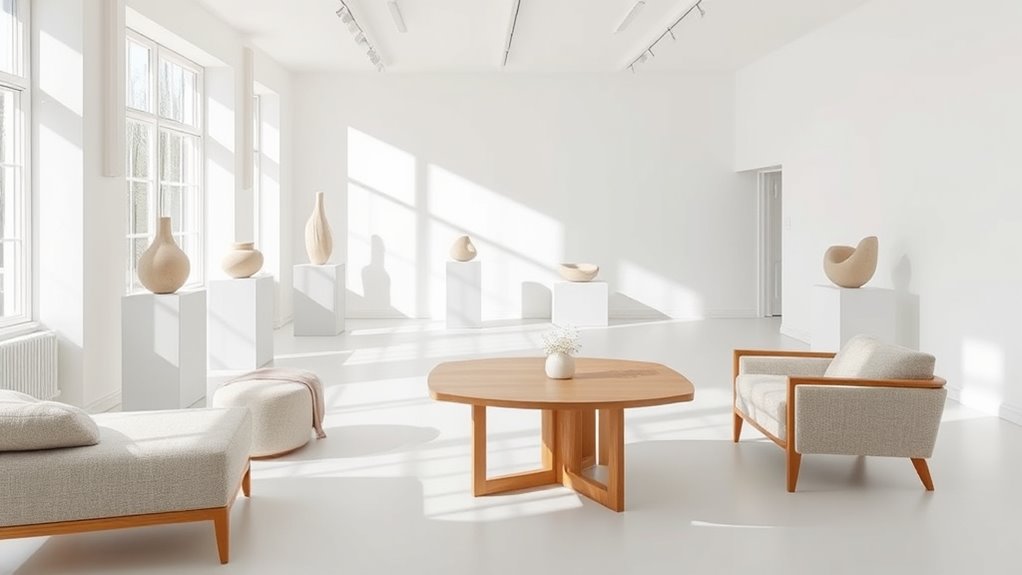
Have you ever noticed how Scandinavian design emphasizes simplicity and practicality? This approach stems from early influences like the Bauhaus movement, which championed functionality and minimal elegance. The 1930 Stockholm Exhibition showcased these ideas, highlighting their importance in Scandinavian design. After WWII, rebuilding efforts demanded affordable, practical solutions, fueling the rise of minimalism. Regional challenges pushed designers to focus on simplicity, using natural materials to connect with the environment. Key figures like Alvar Aalto and Arne Jacobsen advanced these principles through their innovative furniture and architecture. Their work gained international recognition for its timeless appeal and accessibility. This focus on practicality, affordability, and social equality shaped a design philosophy that continues to influence Scandinavian homes and global trends today. Natural materials became central to their work, reflecting both resourcefulness and a deep respect for the environment. Additionally, the functionalism movement significantly contributed to establishing these enduring design ideals. In recent years, sustainability practices have further reinforced the importance of eco-friendly materials and environmental consciousness in Scandinavian design.
Contemporary Artistic Expressions and Innovations
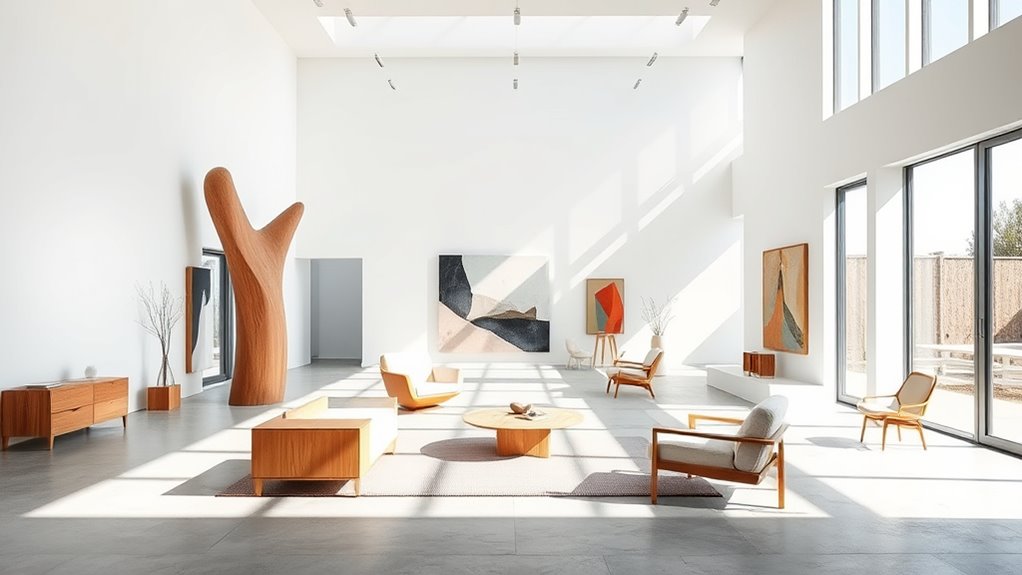
You’ll see how Scandinavian artists are pushing boundaries with digital media, eco-friendly materials, and mixed techniques to create fresh, engaging works. Many focus on environmental and social themes, using their art to raise awareness and spark conversations. Collaborative projects across disciplines and innovative exhibition spaces also highlight their commitment to experimentation and global engagement. Additionally, they are increasingly incorporating natural and sustainable materials into their artwork, reflecting a shared commitment to environmental consciousness.
Innovative Media Techniques
How are contemporary Scandinavian artists pushing the boundaries of media and technology? They’re blending traditional motifs with cutting-edge techniques to create immersive, layered experiences. Here are four key approaches:
- Mixed Media Integration – Combining painting with digital textures, AR, and projection mapping to transform static works into dynamic environments. Incorporating digital textures enhances the depth and interactivity of their art, aligning with the innovative trends in Nordic digital design.
- Innovative Animation – Using minimalist aesthetics, folk narratives, and 3D modeling to craft meditative visuals that reflect Nordic light phenomena.
- Interactive Media – Employing sensors, VR, and motion capture to generate responsive landscapes and folk motifs, enabling personal reinterpretations.
- Traditional Motifs Reimagined – Digitally adapting folk art patterns like rosemaling and kurbits, blending heritage with modern digital design. Recent innovations also include AI-driven techniques, further expanding the creative possibilities in Nordic art.
Environmental and Social Themes
Contemporary Scandinavian artists actively incorporate environmental and social themes into their work, addressing urgent issues like climate change, water scarcity, and ecological imbalance. They explore water’s cultural and ecological significance, challenging traditional narratives with transnational and Indigenous perspectives. Their interdisciplinary approaches blend art history, environmental sciences, and Sámi knowledge to reshape understandings of nature. Here’s a snapshot of their focus:
| Theme | Artistic Approach | Impact |
|---|---|---|
| Sustainability | Recycled materials, eco-friendly design | Promotes ecological responsibility |
| Water and Migration | Symbolic water imagery | Connects environment with identity |
| Activism and Data | Digital works, environmental data | Raises awareness, influences policy |
These innovations foster reflection, activism, and a deeper connection to ecological issues. Exploring artistic innovation can deepen understanding of how these themes are creatively expressed. Incorporating biodiversity into artistic practices encourages a more holistic view of ecological interconnectedness.
Global Collaborative Projects
Global collaborative projects are shaping the Scandinavian art scene by fostering cross-border partnerships and innovative artistic expressions. These efforts connect Nordic artists with international platforms, expanding their reach and influence. For example, the Nordic Pavilion at the Venice Biennale (2026) showcases regional cultural heritage through collaborative efforts from Norway, Sweden, and Finland. Events like Market Art Fair promote Nordic contemporary art, providing networking opportunities and expertise. Scandinavia House hosts exhibitions like “Nordic Models + Common Ground,” emphasizing socially responsible design. Nordic artists blend local traditions with global influences, often using multidisciplinary approaches and natural materials. They incorporate new technologies and cultural commentary, pushing artistic boundaries. This collaborative spirit enhances regional diversity, strengthens global recognition, and fosters innovative, socially conscious artistry. Fostering cross-border partnerships helps nurture shared cultural values and drives creative innovation across the region. Additionally, cultural exchange programs facilitate knowledge sharing and skill development, further enriching the regional artistic landscape. These initiatives also support preservation of regional cultural heritage, ensuring that traditional elements continue to inspire contemporary practices. Moreover, embracing digital collaboration platforms allows artists from different countries to work together seamlessly and showcase their projects to wider audiences. Furthermore, business collaborations can open new funding opportunities and promote sustainable growth in the arts sector.
Urban Art and New Media in Scandinavia
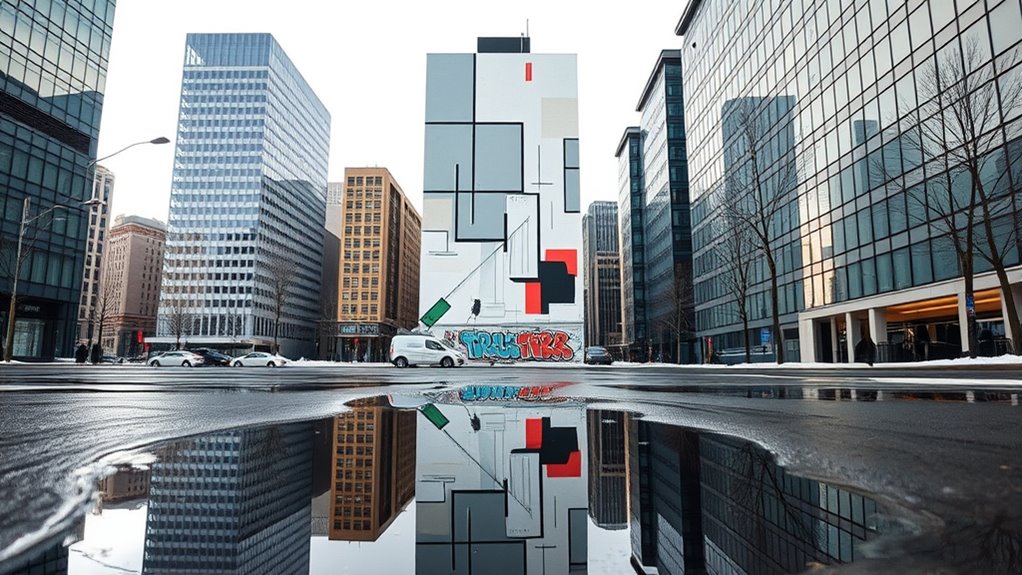
Scandinavia’s urban landscapes have become vibrant canvases for innovative art forms that blend public space with creative expression. Cities like Stockholm, Copenhagen, and Oslo actively incorporate contemporary urban art, transforming everyday environments into open galleries. Many Nordic cities have legalized street art in designated zones, encouraging artists to create murals and installations while reducing illegal tagging. Collaborations between artists and local governments lead to large-scale murals, interactive exhibits, and festivals that engage communities. The themes often reflect societal values such as sustainability, social inclusion, and environmental awareness. Additionally, new media art thrives here, with artists using projections, augmented reality, and real-time data visualization to create dynamic, engaging experiences. These projects foster collective ownership and push the boundaries of urban art. The integration of vetted street art programs ensures that artistic expression remains sustainable and community-oriented.
The Global Impact of Nordic Design and Art
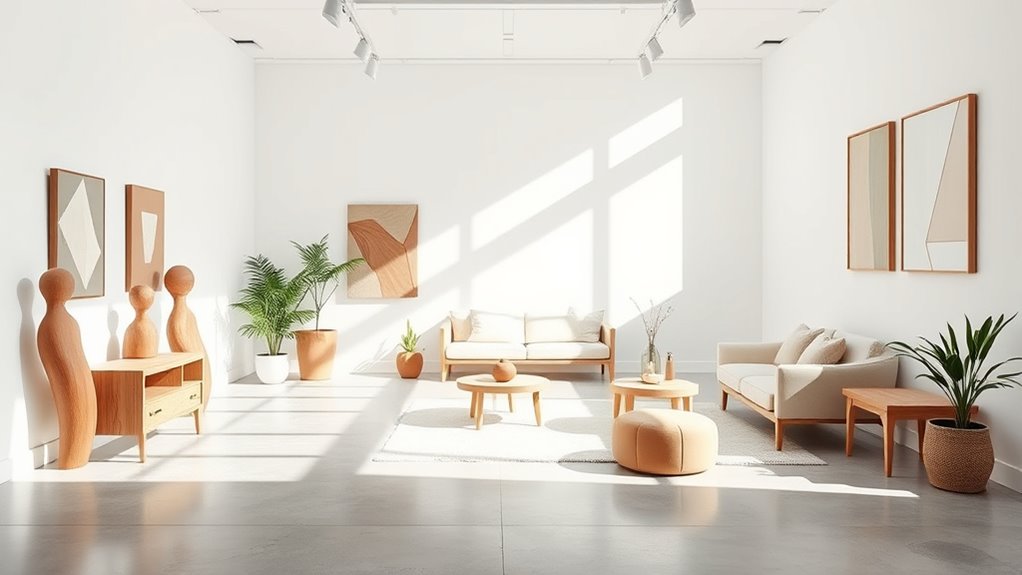
Nordic design has considerably shaped modern aesthetics by making functional, minimalist styles widely accessible and appealing around the world. Its influence on modernism has popularized clean-lined, human-centric designs that emphasize simplicity and usability. You’ll see its impact in global furniture markets, where Scandinavian pieces dominate. Additionally, sustainability is central to Nordic principles, aligning with worldwide eco-conscious trends. Cultural exchanges, especially with the U.S., have helped spread these ideas further. Key designers like Arne Jacobsen and Alvar Aalto have left a lasting legacy, inspiring contemporary work. Furthermore, the emphasis on community and cultural celebrations inspiration has played a role in shaping the inclusive ethos of Nordic design. The integration of AI technology in design processes is opening new avenues for innovation and personalization within Nordic aesthetics.
Cultural Significance and National Identity
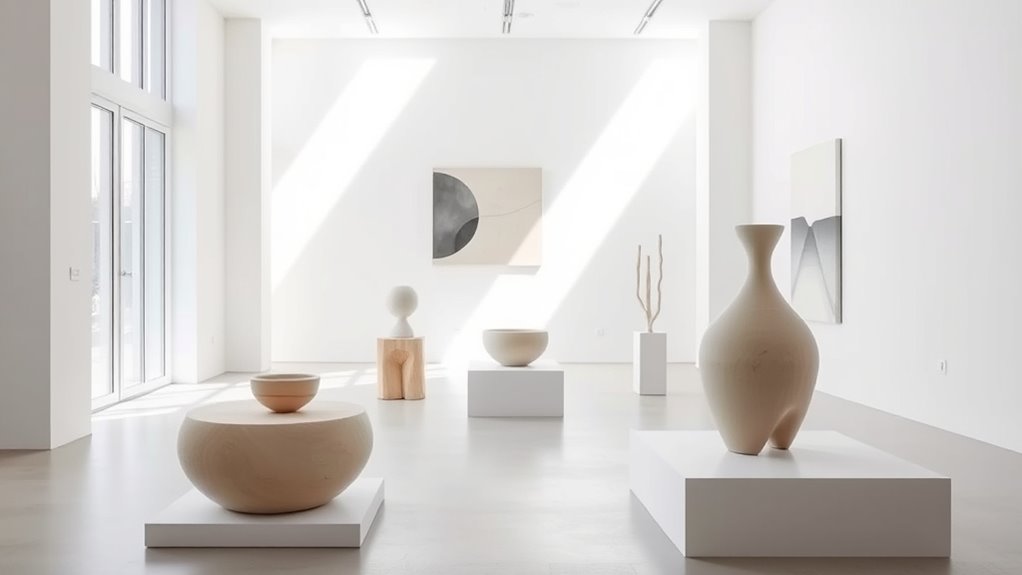
The art scene in Scandinavia is deeply intertwined with the region’s history and cultural identity, serving as a reflection of its people’s values and resilience. You’ll notice how Nordic roots, from Viking heritage to shared traditions, influence themes and motifs, especially in landscapes that symbolize strength and endurance. During the 19th-century Golden Age, romantic nationalism emphasized native themes, reinforcing a sense of pride. Today, Scandinavian art evolves by blending traditional influences with modern elements, showcasing innovation while honoring cultural roots. Governments actively support and preserve this heritage, using art to foster national pride. Public art initiatives engage communities, reinforcing shared identity. Overall, Scandinavian art captures the essence of resilience, nature, and cultural evolution, shaping a distinct national identity recognized worldwide.
Future Directions in Scandinavian Art

Future Scandinavian art will likely see increased use of technology to enhance creativity and customization, making designs more interactive and personalized. Sustainability will continue to shape the scene, with eco-friendly materials and circular approaches becoming standard. Collaborations across disciplines and cultures will bring fresh perspectives, blending traditional craftsmanship with contemporary innovation.
Technological Integration Advances
Advancements in technology are rapidly transforming Scandinavian art, opening new possibilities for creative expression and audience engagement. You now have access to immersive experiences through VR and AR, allowing viewers to step inside art like never before. Digital tools, such as AI-assisted design programs, foster collaboration and innovation, pushing boundaries. 3D printing lets you experiment with new forms and textures, expanding creative horizons. Interactive installations, incorporating sensors and algorithms, deepen viewer involvement. Additionally, virtual galleries and online platforms increase accessibility worldwide, broadening your audience.
- You can craft multi-sensory environments that captivate and involve audiences.
- Collaboration becomes seamless through AI tools, encouraging fresh ideas.
- Experimentation with new materials and textures is simplified via 3D printing.
- Digital platforms break geographic barriers, expanding visibility globally.
Sustainability and Eco-design
As Scandinavian artists and designers embrace sustainability, they’re exploring innovative ways to blend ecological responsibility with aesthetic appeal. They focus on renewable and recycled materials, designing for a circular economy to reduce waste. Eco-friendly practices are integrated throughout the process, emphasizing natural dyes and low-impact production. Trends like biophilic art and natural materials foster a connection with nature, while sustainable color palettes enhance environmental consciousness. Future directions include developing durable, eco-friendly materials, integrating eco-technologies, and adopting circular business models. Community engagement plays a essential role in promoting collective responsibility. Here’s a quick overview:
| Focus Area | Key Practices |
|---|---|
| Material Innovation | Renewable, recycled, durable materials |
| Design Philosophy | Circular economy, minimal waste |
| Community & Tech | Engagement and eco-friendly technologies |
Global Cultural Collaborations
Scandinavian artists and designers are increasingly expanding their reach through vibrant international collaborations that shape the future of the region’s cultural landscape. These initiatives foster cross-border connections and amplify Nordic creativity worldwide.
- The 2025 pilot program supports mobility and artistic exchange across Nordic, UK, and Irish artists, with grants up to €9,000, strengthening global networks.
- The Scandinavian Design Embassy, launched in 2025, unites Nordic countries to promote design innovation and facilitate cross-cultural dialogue at global venues.
- Transatlantic exchanges, like the *Scandinavian Design & USA* exhibit, deepen mutual understanding by showcasing shared design heritage and fostering international partnerships.
- The *Nordic Echoes* exhibition highlights contemporary folk arts, broadening Nordic cultural identity and encouraging international appreciation beyond minimalism.
Frequently Asked Questions
How Does Scandinavian Art Reflect Regional Cultural Values?
You see that Scandinavian art reflects your region’s cultural values by emphasizing community, nature, and simplicity. As you observe folk art, notice how families collaborate on crafts, strengthening bonds. The motifs of flowers, animals, and birds symbolize growth, strength, and harmony, echoing your society’s respect for balance and well-being. This art blurs utility with aesthetics, showcasing your culture’s focus on quality of life, equality, and enduring traditions adapted to modern life.
What Role Do Folk Motifs Play in Contemporary Design?
Have you ever wondered how traditional motifs stay relevant today? Folk motifs in contemporary design serve as a bridge to cultural heritage, adding warmth, personality, and storytelling to modern spaces. You’ll find them in furniture, textiles, and decor, blending tradition with innovation. By embracing vibrant patterns and symbols, designers create emotional connections and celebrate regional identity, making your environment both meaningful and visually enthralling.
How Has Scandinavian Minimalism Influenced Global Architecture?
You see Scandinavian minimalism’s influence in global architecture through its emphasis on simplicity, natural light, and functional spaces. You notice clean geometric forms and sustainable materials shaping iconic buildings worldwide, like the Sydney Opera House. This style promotes eco-friendly designs and cozy environments, inspiring a cultural shift toward moderation and well-being. As it evolves, you can expect even more innovative, sustainable, and globally collaborative architectural projects rooted in Scandinavian principles.
Who Are the Emerging Artists Shaping Modern Scandinavian Art?
You’ll find that emerging artists are shaping modern Scandinavian art through innovative exhibitions and residencies. In New York’s Nordic Echoes, you see artists blending Nordic traditions with contemporary practices. In Sweden, residency programs foster new site-specific works, while events like TRUE NORTH showcase diverse disciplines. Musicians like Y4ska and ORKID are also influencing the scene, pushing boundaries and connecting Nordic minimalism with global trends, shaping the future of Scandinavian art.
In What Ways Does Scandinavian Art Address Environmental Issues?
You see Scandinavian art addressing environmental issues through various powerful ways. Artists use natural elements like soil and wood, reflecting the land’s fragility and beauty. They create artworks that raise awareness about climate change, conservation, and ecosystems. Many involve communities in environmental dialogue, and some collaborate with scientists. These artworks often serve as social commentary, promoting sustainability and encouraging action while highlighting the importance of preserving natural heritage.
Conclusion
Imagine Scandinavian art as a gentle stream, flowing from ancient folk roots into a vast ocean of modern innovation. You’re invited to join this journey, where minimalism and functionality serve as the guiding currents, shaping not just aesthetics but cultural identity. Embrace this evolving landscape, knowing that each new wave reflects a legacy of simplicity and purpose. As you navigate, remember that true artistry transforms the everyday into something timeless and profound.


